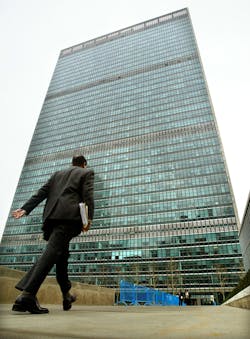The National Institute of Building Sciences Sustainable Buildings Industry Council recognized the recipients of 2015 Beyond Green High-Performance Building and Community Awards during a luncheon Jan. 14 at Building Innovation 2016: The National Institute of Building Sciences Fourth Annual Conference and Expo in Arlington, Va.
Honor Award
The Honor Award, the top prize in the High-Performance Buildings category, went to the United Nations (U.N.) Headquarters in New York City for its sustainable renovation project.
“This amazing, complex project set out to tackle multiple high-performance-building attributes,” Jim Whittaker, Beyond Green juror and president of Facilities Engineering Associates, said. “In addition to addressing sustainability, the project naturally focused on historic preservation, safety and security, and accessibility. It certainly provides a glimpse into what is possible.”
Built in 1950, the U.N. campus had aged and inefficient infrastructure, code-compliance issues, and materials containing asbestos. The renovation began in 2008 and was completed in June 2015. The three major goals of the renovation were: serve as an example for sustainable renovation projects, preserve the historic nature of the facility, and bring the facility up to current building-code levels. At its height, the $2 billion project employed more than 650 contractors and design/construction professionals. LEED, or Leadership in Energy & Environmental Design, Gold certification was earned for the campus, while LEED Platinum certification was earned for the Secretariat tower. The campus is expected to achieve 50 percent energy savings. Throughout the renovation, 50 percent of the campus remained occupied, requiring careful phasing of the new infrastructure.
“At the time it was built, it was a highly innovative building with the newest technologies,” Mike Thoresen, PE, of Syska Hennessey Group, a contractor on the project, said. “It hadn’t changed much in 50 years.” After the renovation, “It looks almost exactly the same. It was preserved, but upgraded.”
Merit Awards
The Award of Merit in Category A: High-Performance Buildings went to the Center for Sustainable Landscapes (CSL) at Phipps Conservatory and Botanical Gardens in Pittsburgh. A dilapidated brownfield, once used as a fueling and supply station for the City of Pittsburgh’s Department of Public Works, was transformed into a 2.9-acre site hosting one of the world’s greenest buildings, a landscape of native plants, and a slate of science education programs.
“The utilization of an interdisciplinary design charrette to transform this environmentally degraded brownfield site into a highly visible demonstration of what is possible is impressive,” Keith Diaz-Moore, Beyond Green juror and dean of the College of Architecture and Planning at the University of Utah, said. “The desire to capture and expand local design talent is commendable.”
The result of a unique, facilitated integrated-design process, the 24,350-sq-ft CSL at Phipps Conservatory and Botanical Gardens generates all of its own energy, captures and treats all water on site, and is the first and only project to attain the planet’s highest sustainable-building certifications: Living Building Challenge, LEED Platinum, 4 Star Sustainable SITES, and WELL Platinum.
The Award of Merit in Category C: High-Performance Initiatives went to the Efficient Homes Initiative of the Northwest Energy Efficiency Alliance (NEEA) and its utility partners.
“This multistate effort, focused on the expansion of energy-efficient homes, provides a model for potential programs of this nature across the country,” Mary Ann Lazarus, Beyond Green juror and principal of MALeco, said. “While energy efficiency was the main goal, the initiative recognizes the linked benefits for health, water use, and sustainability.”
Since 2012, the NEEA and its utility partners have sought to accelerate the market adoption of energy-efficient homes. Working with the U.S. Environmental Protection Agency, the NEEA established a program that provides builders in the Northwest with regional marketing, recruitment, and training support and gives verifiers and raters the tools they need to verify and certify energy-efficient homes. As part of the pilot program, a group of Northwest homes was designed to be more energy-efficient and then monitored for performance to identify the most cost-effective ways to achieve maximum energy savings. Since its inception, the pilot has included more than 100 participating homes across Idaho, Montana, Oregon, and Washington. Once a pilot home is built and occupied, the program monitors it for 13 months to track its performance and ensure it meets desired efficiency goals. Pilot homes are at least 30 percent more energy-efficient than homes built to state-specific energy codes, with many exceeding that number. The monitoring provides a trove of data that will push future building energy codes in the Northwest.
“Since the inception of this program, we’ve brought on close to 150 projects, achieving a 30 percent above-code performance target,” Neil Grigsby Sr., program manager for the Efficient Homes Pilot Video Campaign, said.
For case studies of Beyond Green winners from previous years, visit the WBDG Whole Building Design Guide.










